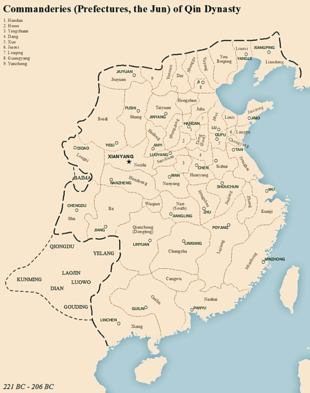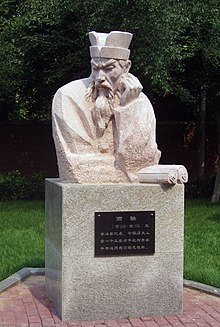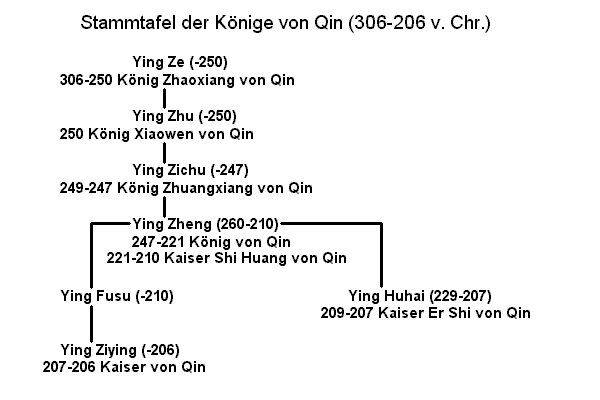Qin dynasty
![]()
This article is about the Chinese Qin dynasty (221-207 BC). For smaller Qin empires in the period 350-417 AD, see Early Qin and Later Qin.
The Qin Dynasty (Chinese 秦朝, pinyin Qíncháo, W.-G. Ch'in Ch'ao) was the first dynasty of the Chinese Empire. It arose from the state of Qin, the westernmost of the seven states that vied for supremacy during the period of the Contested Empires. Qin succeeded in conquering all rival empires by 221 BC, uniting all Chinese-populated territory under one crown for the first time. This was the culmination of a development that had already begun in previous centuries, and one of the most important events in China's history. After the unification of the empire, the Qin king Zheng assumed the title of emperor; he is therefore known as Qin Shihuangdi. However, the real architect of the Unified Empire is considered to be its chancellor Li Si. The territory controlled by the Qin dynasty was much larger than that controlled by its predecessors, such as the Shang or Zhou dynasties.
The few years that the Qin dynasty lasted are among the most politically creative periods in Chinese history. Building on the philosophy of legalism, Qin created the basic features of the Chinese state system that endured in the centuries that followed: the imperial bureaucracy, systematic registration of the population and lands for taxation purposes, legitimization of the emperorship, construction of a wall to protect against the peoples of Inner Asia, and the use of uniform measurements, writing, and currency throughout the empire. Last but not least, the name China is derived from the word Qin.
After the death of the first emperor in 210 BC, unrest broke out throughout the country. Despite the Qin's military strength, the ensuing civil war brought down the dynasty. In 207 BC, the rebel Xiang Yu had the third Qin emperor Ziying executed, shortly after which Liu Bang founded the Han dynasty.
For a long time, Chinese historiography unilaterally condemned the Qin dynasty as barbaric and militaristic. Even among Western scholars, the Qin were long considered a typical example of totalitarianism. In recent decades, however, the analysis of archaeological finds has led to a more balanced picture.

Qin dynasty area
Origin and rise of the Qin state
The State of Qin
→ Main article: Qin (state)
The origins of the Qin lie in the Zhou dynasty. The Zhou kings granted fiefs to relatives, allies, or members of the overthrown House of Shang to ensure their loyalty. This division of land gradually led to the political fragmentation of the empire. Thus, during the Spring and Autumn Periods, there were about 170 states, which in turn were again divided into fiefs. Meanwhile, the Zhou lords lost their importance. This fragmentation consolidated until the time of the Disputed Empires, in which 7 states fought each other. These states were independent of each other and viable. They largely shared a common language and culture, but there were borders, tariffs, shifting alliances, intrigues, and wars.
In 897 BC, Feizi was given a fief near present-day Tianshui (Gansu Province) by the Zhou king to breed horses for the royal court. Feizi's descendants took the title of duke (gong) not long after and gained influence; in 770, the Zhou king was even forced to seek the protection of this new dynasty from a Rong attack. In return, Qin was also elevated to a duchy by the king. The exact origin of Qin's population is unknown. Due to its location, the inhabitants and ruling dynasty of Qin were influenced by or even descended from non-settled Inner Asian peoples, although the state was in constant struggle with these same nomadic neighbors until the 5th century BC. At the same time, Chinese culture and its customs were gradually adopted.
During the rise and growth of Qin, the capital was moved several times; from about 350 BC, it was located in present-day Xianyang near Xi'an; the region around Xi'an known as the area within the passes (Guanzhong) was to remain the center of the Chinese empires for centuries thereafter. Until then, Qin was considered an outsider and "barbarian" by its rivals because of its location, but also because of its low cultural development. However, under the rule of Duke Xiao and his advisor Shang Yang, between 361 and 338 BC, profound reforms were carried out in the spirit of the philosophical current of Legalism, which gave Qin advantages over its neighbors, especially in agriculture, administration, and economic policy. In 325, the Qin rulers finally assumed the title of king, as the monarchs of the other states had already done.
Military expansion
Since its inception, the Qin kingdom had grown steadily, expanding primarily to the west and northwest. The actual military expansion of the Qin state began in 316 BC, when Shu and later Ba (the regions of present-day Chengdu and Chongqing, modern Sichuan) were conquered, decisively weakening the rival Chu on its southern border. In 256, it was Qin again that wiped out the Zhou dynasty, although this no longer had much political significance at the time due to its weakness. The neighboring powers, meanwhile, tried to halt Qin's expansion either through alliances against Qin or through appeasement.
Thus, three assassination attempts on the Qin king Zheng have survived. One of these assassinations was carried out in 227 BC by the envoy of the state of Yan, who had traveled to the Qin king with a document of submission, a map of Yan, and the head of a defected Qin general. Another action to stop the advance of Qin was the construction of the 120 km long Zheng Guo Canal north of the capital Xianyang, planned by Zheng Guo who had come from Han. Allegedly, the goal of the instigators of this plan was to drain resources from Qin's economy through this giant project, thus weakening the state. Although this "conspiracy" was uncovered, they finished building the canal; the economic benefits from the project further strengthened Qin. According to the chronicles, the exposure of this conspiracy led Qin to plan to expel all foreigners. However, this probably does not correspond to historical facts.
For the last years before the unification of the empires, the chronicles report a large number of military conflicts with such astronomical army strengths and numbers of victims that doubts about the correctness of the data are almost imposing. The six empires that existed alongside Qin were eventually conquered in rapid succession: Han (230), Chao (228), and Wei (225), which were located to the east of Qin, then 223 Chu to the south, and finally Yan and Qi to the northeast (222 and 221, respectively).
Reasons for the success of the Qin State
Why of all states, originally the least culturally developed and on the fringes of Chinese territory, was able to develop the strength to unify the empire is the subject of much research. A whole series of factors contributed to this development:
- the establishment of an efficient administration. Reforms begun under Prince Xiao and his advisor Shang Yang, which implemented the theories of the philosophical current of Legalism, resulted in Qin having the most efficient state system among all Chinese empires at the time. Based on Legalism, which emphasized governing by law rather than Confucianist governing by virtue, laws were created, punishments or even rewards were given for certain actions, and numerous executive orders and norms were issued. A report from 264 BCE, for example, describes Qin officials as feared but impartial. Another significant innovation was the introduction of two chancellorships, one on the left and one on the right. The term bureaucratic state centralism was coined for the Qin kingdom's form of government. Qin's neighboring states were also influenced by legalistic ideas; however, Qin was the most consistent in implementing its ideas.
- military strength. Due to the constant confrontation with the nomads through the reforms of General Wei Ran, Qin had a trained and powerful army. In addition, the registration of all households that had just been introduced at the time allowed for efficient recruitment of soldiers. However, theories that Qin may have also had military advantages due to advances in ironworking are invalidated by archaeological findings; the weapons found were mostly made of bronze, while the iron, which was mostly cast at the time, was soft and brittle. As the period of the rise of the Qin state also saw the transition from chariot to massive infantry armies combined with the use of crossbowmen as the dominant form of warfare, the ability of the administration to recruit forces at short notice was crucial.
- Concentration of all power and authority on one ruler, instead of distributing it among vassals as before. This innovation goes back to the philosopher Fan Sui.
- Improvements in agriculture. The well-field system, which had dominated until then, was abolished and the area used for agriculture was expanded. Farmers from other states were settled in the hitherto sparsely populated Qin territory. Taxes replaced drudgery, and land was made available for purchase and sale. Yields increased as a result, because the income of the peasants grew directly with the yields. In addition, canal constructions made extensive lands usable; however, the effect of these constructions did not occur until Qin was well advanced in its expansion. More efficient agriculture enabled the growth of cities and the provision of labor for the construction of roads and bridges.
- willingness to accept foreigners in high positions. Personalities such as Shang Yang, Lü Buwei, or Li Si were all not from Qin, but came from rival states where they could not attain the positions they sought. However, the implementation of their ideas was decisive for the state organization of Qin and ultimately for its breakthrough. Only in the case of military leaders did Qin not need foreigners.
- the location of Qin, which was protected by mountain ranges and the Yellow River. It was thus protected from attacks by rival neighboring empires and could operate from this cover.
- a series of competent and long-lived rulers, which brought continuity and stability.

Shang Yang
Family Tree
→ Main article: Emperor of the Qin dynasty

Search within the encyclopedia